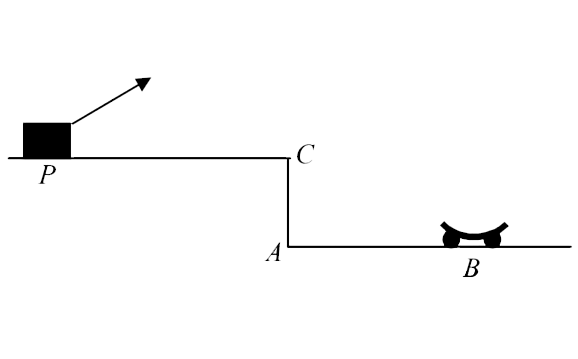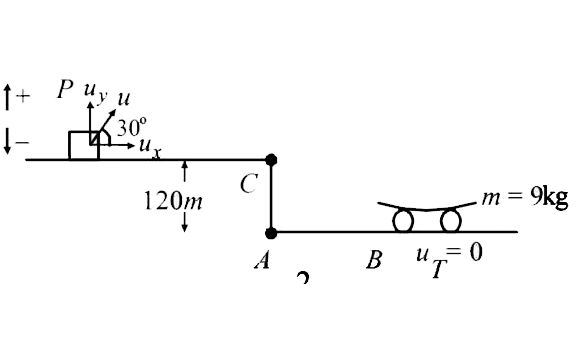A car P is moving with a uniform speed 5√3m/s towards a carriage of mass 9 kg at rest kept on the rails at a point B as shown in figure. The height AC is 120 m. Cannon balls of 1 kg are fired from the car with an initial velocity 100m/s at an angle 30∘ with the horizontal. The first cannon hall hits the stationary carriage after a timet0 and sticks to it. Determine t0.

At t0, the second cannon ball is fired. Assume that the resistive force between the rails and the carriage is constant and ignore the vertical motion of the carriage throughout. If the second ball also hits and sticks to the carriage, what will be the horizontal velocity of the carriage just after the second impact?
The correct Answer is:A, B
Consider the vetical motion of the cannon ball
uy=+100sin30∘
sy=−120m
ay=−10m/s2
t=t0
s=ut+12at2∴−120=50t0−5t20
⇒t20−10t0−24=0
∴t0=(−10)±√100−4(1)(−24)2=12or−2 [Not valid]
∴t0=12sec.

The horizontal velocity of the cannon ball remains the same
∴ux=100cos30∘=50√3ms−1
∴ Applying conservation of linear momentum to the
cannon ball-trolley system in horizontal direction. If m is the mass of cannon ball and M is the mass of the trolley then,
μx+M×0=(m+M)vx
∴vx=muxm+M where vx is the velocity of the
cannon ball-trolley system.
∴vx=1×50√31+9=5√3m/s
The second ball also struck the trolley,
Therefore, in time 12 seconds, the trolley covers a distance
of 60√3m.
For trolley after 12 seconds,
u=5√3m/s,v=?,t=12s

s=60√3m,s=ut+12at2
⇒60√3=5√3×12+12×a×144
∴a=0m/s2∴v=u+at=5√3m/s.
To find the final velocity of the carriage after the second
impact we again apply conservation of linear momentum in
the horizontal direction
μx+(M+m)vx=(M+2m)vf
∴1×50√3+(9+1)5√3=(9+2)vf
⇒vf=15.75m/s
Topper's Solved these Questions
Similar Questions
A car P is moving with a uniform speed 5√3m/s towards a carriage of mass 9 kg at rest kept on the rails at a point B as shown in figure. The height AC is 120 m. Cannon balls of 1 kg are fired from the car with an initial velocity 100m/s at an angle 30∘ with the horizontal. The first cannon hall hits the stationary carriage after a timet0 and sticks to it. Determine t0.

At t0, the second cannon ball is fired. Assume that the resistive force between the rails and the carriage is constant and ignore the vertical motion of the carriage throughout. If the second ball also hits and sticks to the carriage, what will be the horizontal velocity of the carriage just after the second impact?View SolutionA cannon of mass 100 kg is kept on a frictionless floor. If a cannon ball of mass 1 kg is fired from it with a speed of 200 m/s. With what velocity the cannon will move ?
View Solution
Knowledge Check
- Question 1 - Select One
A canon of mass 150 kg shot a cannon ball of 1.5 kg which goes with a velocity of 60 m/s. the cannon will recoil with a speed of
A10.5 m/sB6 m/sC0.6 m/sDNone of these - Question 2 - Select One
A shell is fired from a cannon with a velocity 20m/s at an angle 60∘ with the horizontal. At the highest point it explodes into three pieces of equal masses . One of the pieces retraces its path to the cannon , the second piece moves vertically up with speed 40m/s , the third piece will move with velocity (immediately after the explosion)
A20m/s in a horizontal directionB40m/s at an angle 45∘ with horizontal in an upward directionC40√2m/s at an angle 45∘ with horizontal in an upward directionD40√2m/s at an angle 45∘ with horizontal in the downward direction - Question 3 - Select One
A shell is fired from a cannon with a velocity v(m/s) at an angle θ with the horizontal direction. At the highest point in its path it explodes into two pieces of equal mass. on, of the pieces retraces its path to the cannon and the speed, (in m/s) of the other piece immediately after the explosion is
A3vcosθB2vcosθC32vcosθD√32vcosθ
A cannon of mass 100 kg is kept on a frictionless floor. If a cannon ball of mass 1 kg is fired from it with a speed of 200 m/s. With what velocity the cannon will move?
View SolutionA shell is fired from a cannon with a velocity v(m/sec.) at an angle θ with the horizontal direction. At the highest point in its path it explodes into two pieces of equal mass. One of the pieces retraces its path to the cannon and the speed (in m/sec.) of the other piece immediately after the explosion is
View SolutionA shell is fired from a cannon with a velocity v(m/sec.) at an angle θ with the horizontal direction. At the highest point in its path it explodes into two pieces of equal mass. One of the pieces retraces its path to the cannon and the speed (in m/sec.) of the other piece immediately after the explosion is
View SolutionA cannon of mass 150 kg shot a cannon ball of 1.5 kg which goes with a velocity of 60 m/s. The cannon will 'recoil with a speed of
View SolutionA cannon of mass 150 kg shot a cannon ball of 1.5 kg which goes with a velocity of 60 m/s. The cannon will recoil with a speed o
View Solution

